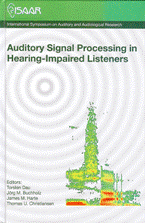The temporal dynamics of pitch perception and what they reveal about processing mechanisms
Abstract
Hearing impairment can severely restrict the ability to communicate through speech in noisy environments. One of the most important cues for segregating wanted from unwanted sounds is temporal regularity, or harmonicity in the frequency domain, giving rise to the perception of pitch. However, pitch is a strong segregation cue only in the low-frequency region, where harmonic components are spectrally at least partially resolved. In contrast, spectrally unresolved pitch, produced by high-frequency sounds, is a much weaker segregation cue. This and other differences led to the assumption that resolved and unresolved pitch are processed by different mechanisms – a spectral one for resolved pitch and a temporal one for unresolved pitch. The aim of this study was to test this assumption by measuring the temporal dynamics of pitch perception in the resolved and unresolved regions. For that, the threshold for the detection of a gap in the autocorrelation function of iterated rippled noise was measured as a function of the pitch value and the spectral region of the stimulus. The minimum detectable gap duration would be expected to be largely independent of pitch value, if pitch were processed spectrally. Contrary to this expectation, we found that the minimum detect-able gap duration decreases with increasing pitch value in an approximately reciprocal way, suggesting that pitch is processed temporally even in the low-frequency region. The experimental data are compared to predictions from models of auditory temporal processing.
References
Darwin, C. J., and Hukin, R. W. (2000). “Effectiveness of spatial cues, prosody, and talker characteristics in selective attention,” J. Acoust. Soc. Am. 107, 970-977.
de Cheveigné, A. (2005). “Pitch perception models, Pitch: Neural Coding and Perception, Edited by C. Plack and A. Oxenham, New York, Springer Verlag.
Hall, J. W. 3rd, Buss, E., and Grose, J.H. (2003). “Modulation rate discrimination for unresolved components: temporal cues related to ne structure and envelope,” J. Acoust. Soc. Am. 113, 986-993.
Meddis, R., and O’Mard, L. (1997). “A unitary model of pitch perception,” J. Acoust. Soc. Am. 102, 1811-1820.
Vliegen, J., Moore, B. C., and Oxenham, A. J. (1999). “The role of spectral and periodicity cues in auditory stream segregation, measured using a temporal discrimination task,” J. Acoust. Soc. Am. 106, 938-945.
Yost, W. A., Patterson, R., and Sheft, S. (1998). “The role of the envelope in processing iterated rippled noise,” J. Acoust. Soc. Am. 104, 2349-2361.
Wiegrebe, L., Hirsch, H. S., Patterson, R. D., and Fastl, H. (2000). “Temporal dynamics of pitch strength in regular-interval noises: effect of listening region and an auditory model,” J. Acoust. Soc. Am. 107, 3343-3350.
Additional Files
Published
How to Cite
Issue
Section
License
Authors who publish with this journal agree to the following terms:
a. Authors retain copyright* and grant the journal right of first publication with the work simultaneously licensed under a Creative Commons Attribution License that allows others to share the work with an acknowledgement of the work's authorship and initial publication in this journal.
b. Authors are able to enter into separate, additional contractual arrangements for the non-exclusive distribution of the journal's published version of the work (e.g., post it to an institutional repository or publish it in a book), with an acknowledgement of its initial publication in this journal.
c. Authors are permitted and encouraged to post their work online (e.g., in institutional repositories or on their website) prior to and during the submission process, as it can lead to productive exchanges, as well as earlier and greater citation of published work (See The Effect of Open Access).
*From the 2017 issue onward. The Danavox Jubilee Foundation owns the copyright of all articles published in the 1969-2015 issues. However, authors are still allowed to share the work with an acknowledgement of the work's authorship and initial publication in this journal.


